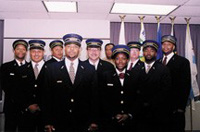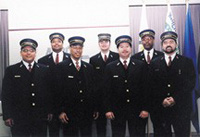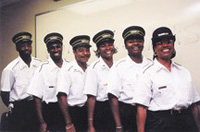|
The Metra Commuter Rail Service in Northeast Illinois provides about 300,000 passenger trips a day to and from Chicago around 83 million annually. That’s a lot of exposure for a uniform, and from the first day of their training when their measurements are taken, would-be conductors are made very aware of that fact.
Deeanne M. Kroner, chief programs officer who oversees Metra’s Assistant Conductor Training Program, says, “I have always believed that a uniform makes a presentation in this case, with our conductors. First of all, the uniform is tradition you have to remember that with the railroad. Number two, the uniform provides a sense of authority. The conductor is the manager of the train. It’s the conductor’s responsibility to make sure that the train crew are doing their jobs and taking care of their passengers. In commuter service, it’s important to have a presence. The conductor’s uniform provides that ‘presence of authority,’ someone the customer can come to. I think it represents also a sense of security. You have someone who you can trust, who you can ask questions of, who you can get information from, who will help you with a situation, who you can bring a problem to as you’re riding through the system. Finally, our uniform is a symbol of pride. Pride of the individual and also a symbol of pride for Metra.”
Designing a uniform that meets all of these goals is not a simple task. So when it came time last year for Metra to update its uniforms, many factors needed to be considered. First and foremost among them was the need to always keep in mind the traditional image of a train conductor.
Mary Brady, who oversees Metra’s uniform program, explains that the provider, Cintas, “tried to give the uniform a contemporary, stylish appearance while still maintaining the traditional significance and appeal of the old uniforms. They changed the style slightly and darkened the color.”
The changes were subtle enough that even frequent passengers might not notice them at first, but one change that was appreciated by the conductors themselves was the slenderized appearance of the jackets. Brady jokes that “like with anything else, you’ll always have some complainers, but the majority of the personnel seems very satisfied believe me, if they weren’t, I’d hear about it.”
As with any government institution, Metra’s uniform contract was open for public bid. While Cintas was the lowest bidder, cost wasn’t the only factor that earned it the contract. Brady says that “Cintas put together a very good package. They took over from our last uniform company when they went out of business, so when it came time for a new contract, I felt Cintas was best for us because we were already established with them. They knew our product, what was expected and we didn’t have to get used to working with new people. They’ve been very good with us.”
Metra provides its conductors with two sets of uniforms per year, but operating the uniform program is challenging because of the many choices a conductor has in designing his or her wardrobe. “If their inventory has enough coats, they can opt to change the coats for some extra shirts, so it’s not cut and dried. It’s very individual-based,” Brady says. Cleaning the uniforms is the conductor’s responsibility.
The basic Metra uniform consists of deep navy pants and jacket (both Raeford, in 14 oz. and 11 oz. weights depending on the season), tie (three designs and three styles 4-in-hand, clip-on, and knit scarf to choose from), optional dark navy V-neck sweater (pill-resistant fiber, heavyweight knit, worn under the jacket) and hat. The only adornments to the uniform are lapel and button brass on the jackets and brass on the hat. A white dress shirt (65/35 poly/cotton broadcloth weave) completes the picture. The conductor provides his own black shoes and socks.
But with the change of seasons and the simple fact that the doors to the trains are constantly opening and closing, Metra’s uniform has to be flexible.
To this end, each conductor is provided a summer hat (mesh-topped instead of cloth) and a summer-weight shirt (62/38 poly/cotton). This shirt has epaulettes and is more formal than the heavyweight model and designed to be worn without a jacket or tie. However, as the jacket and tie are the preferred uniform choices, conductors only have a few months of the year during which they are allowed to sport the more casual look.
With all the aesthetic and comfort choices available to its conductors, Metra chooses to let Cintas handle its inventory. All orders are put into a database, and each of Metra’s districts has its own contact person. Metra keeps no inventory on-hand, opting to let Cintas ship out new uniform pieces as needed.
At the completion of their 10 weeks of rigorous training, assistant conductors wear their full uniforms for the first time at graduation. Kroner says the transformation from their everyday wear to their uniform is sometimes shocking. “The first time you see them, they’re all sitting there in their jeans and t-shirts and who knows what’s on the t-shirts. And then to see them at graduation, oh my goodness, what a change.”
Kroner impresses upon her students the importance of “a uniform that’s crisp-looking, that’s neat at all times, that’s clean.” And certainly a conductor’s appearance is under constant observance, as many of Metra’s employees use the service to get to work themselves.
But the focus on cleanliness is just one aspect of Metra’s uniform credo. All of the facets of Metra’s uniform the appearance, color, traditional design feed into Metra’s focus on the conductor’s uniform as a symbol of pride and authority. Kroner says, “I have been a great proponent of uniforms throughout my career. I don’t know whether that goes back to parochial school, when I wore a uniform, but I’ve always believed in the uniform. I think that when you have a uniform, you have a responsibility that you carry with it.
“When we talk about pride and authority [to the trainees], they’re carrying that with them as part of the responsibility when they put on that uniform. If service is disrupted, the conductor confidently walking through the train in his or her uniform gives the commuters a feeling of security. As Metra perceives it, body language and uniform meld together to project the desired positive image to its many riders.”
The authority and responsibility that comes with the Metra uniform was never more evident than on Sept. 11, when the train service had to assist thousands of commuters fleeing downtown Chicago following the evacuation of many of its major downtown buildings. Metra’s conductors were praised for their calm demeanor and the swiftness of their response. And their uniform? Mary reports that many letters Metra received mentioned how reassuring it was to see the men in their uniforms and the sense of security it conveyed. As one rider put it, “they were very visible… controlling all the confusion.”
There are times a uniform is more than just a uniform.
|













